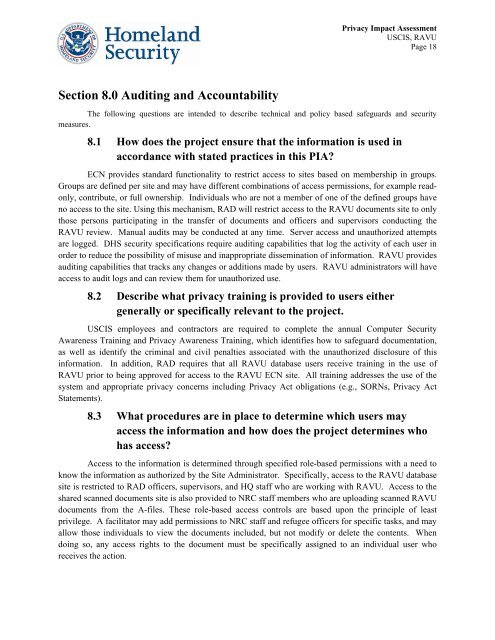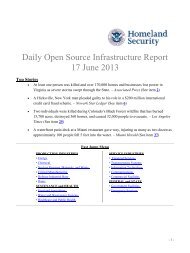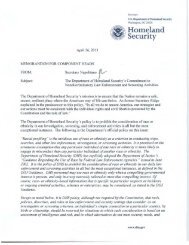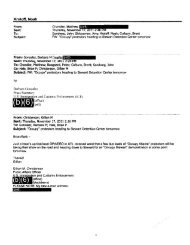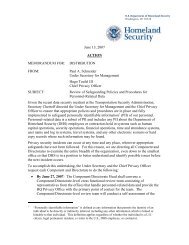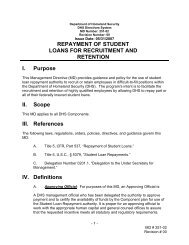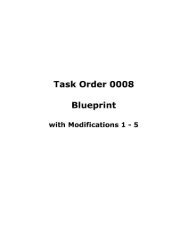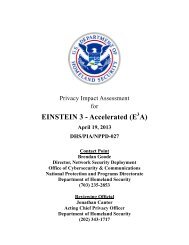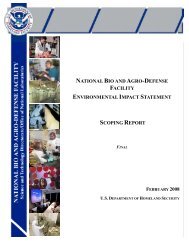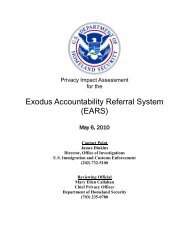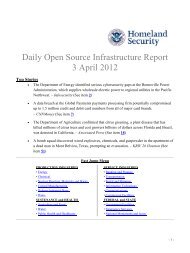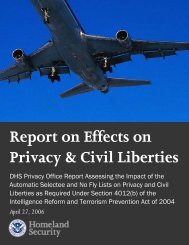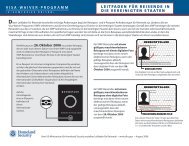RAVU - Homeland Security
RAVU - Homeland Security
RAVU - Homeland Security
You also want an ePaper? Increase the reach of your titles
YUMPU automatically turns print PDFs into web optimized ePapers that Google loves.
Privacy Impact AssessmentUSCIS, <strong>RAVU</strong>Page 18Section 8.0 Auditing and AccountabilityThe following questions are intended to describe technical and policy based safeguards and securitymeasures.8.1 How does the project ensure that the information is used inaccordance with stated practices in this PIA?ECN provides standard functionality to restrict access to sites based on membership in groups.Groups are defined per site and may have different combinations of access permissions, for example readonly,contribute, or full ownership. Individuals who are not a member of one of the defined groups haveno access to the site. Using this mechanism, RAD will restrict access to the <strong>RAVU</strong> documents site to onlythose persons participating in the transfer of documents and officers and supervisors conducting the<strong>RAVU</strong> review. Manual audits may be conducted at any time. Server access and unauthorized attemptsare logged. DHS security specifications require auditing capabilities that log the activity of each user inorder to reduce the possibility of misuse and inappropriate dissemination of information. <strong>RAVU</strong> providesauditing capabilities that tracks any changes or additions made by users. <strong>RAVU</strong> administrators will haveaccess to audit logs and can review them for unauthorized use.8.2 Describe what privacy training is provided to users eithergenerally or specifically relevant to the project.USCIS employees and contractors are required to complete the annual Computer <strong>Security</strong>Awareness Training and Privacy Awareness Training, which identifies how to safeguard documentation,as well as identify the criminal and civil penalties associated with the unauthorized disclosure of thisinformation. In addition, RAD requires that all <strong>RAVU</strong> database users receive training in the use of<strong>RAVU</strong> prior to being approved for access to the <strong>RAVU</strong> ECN site. All training addresses the use of thesystem and appropriate privacy concerns including Privacy Act obligations (e.g., SORNs, Privacy ActStatements).8.3 What procedures are in place to determine which users mayaccess the information and how does the project determines whohas access?Access to the information is determined through specified role-based permissions with a need toknow the information as authorized by the Site Administrator. Specifically, access to the <strong>RAVU</strong> databasesite is restricted to RAD officers, supervisors, and HQ staff who are working with <strong>RAVU</strong>. Access to theshared scanned documents site is also provided to NRC staff members who are uploading scanned <strong>RAVU</strong>documents from the A-files. These role-based access controls are based upon the principle of leastprivilege. A facilitator may add permissions to NRC staff and refugee officers for specific tasks, and mayallow those individuals to view the documents included, but not modify or delete the contents. Whendoing so, any access rights to the document must be specifically assigned to an individual user whoreceives the action.


